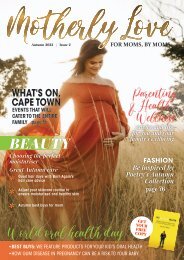Motherly Love Summer 2021
Motherly Love is a family lifestyle brand that is aimed to inform & inspire modern women through the journey of motherhood
Motherly Love is a family lifestyle brand that is aimed to inform & inspire modern women through the journey of motherhood
Create successful ePaper yourself
Turn your PDF publications into a flip-book with our unique Google optimized e-Paper software.
BABY breastfeeding
It’s also important to note that
breastfeeding newborn babies should
not be expected to sleep through the
night! Your body secretes the largest
amount of prolactin, the main
hormone involved in milk
production, in the middle of the
night. Thus, nighttime feedings are
important in boosting and
maintaining mothers’ milk flows.
Trying to put a newborn baby (less
than one month of age) onto a strict
breastfeeding schedule can lead to a
significant decrease in one’s supply.
Q. What can I do about sore
nipples?
A. Sore nipples are common, and
up to 90% of breastfeeding moms
experience some degree of nipple
soreness early on. Treatments for
sore nipples include warm, moist
heat; nipple ointments and creams;
and hydrogel pads. Breast massage
and wearing comfortable bras can
also help.
Persistent nipple pain can be a sign
that your baby is not latching on
correctly. This can be a result of
baby’s latch being too shallow, a
tongue-tie, and/or too much suction
being present as your baby comes off
of your breast. The best way to
troubleshoot a painful latch is by
working with a lactation specialist.
Nipple shields, which are thin, silicone
sleeves that fit over the nipple/areolar
region, can be used as a temporary
tool to help with problematic latches.
It’s very important to have a
professional help you choose nipple
shields that are the correct size for
your breasts. Some women with large
breasts actually need smaller-sized
nipple shields and vice versa. In
addition, some moms may find that
certain brands of shields work better
than others.
Sore nipples can sometimes
improve if different nursing positions
are used as well. ‘Laid-back’, or
reclined breastfeeding, is increasingly
being used to promote maternal
comfort and proper latching.
Q. Any tips for getting past
shyness of feeding in front of other
people—especially those
unsupportive of nursing?
A. It’s really important to be
patient with yourself and your baby
as you bond with each other and
learn how to breastfeed. Like
learning any new skill, it’s best to
practise without an audience around.
The first few postpartum weeks often
involve countless hours of being
topless and having ‘skin-to-skin’
time with your baby between
breastfeeding sessions. This is not
the optimal time to have lots of
visitors and/or prolonged visits with
family and friends.
Once breastfeeding is wellestablished,
we recommend starting
to feed around supportive loved ones
first. This is also a good time to
practise with nursing apparel and
cover-ups to see which ones are the
most comfortable for you and your
baby as you prepare for how you will
comfortably nurse in public.
Q. I started pumping and have
noticed one breast produces more
milk. Does that mean my baby isn’t
getting enough sustenance on the
other side?
A. One mom had the exact same
question when she had her oldest
baby and started pumping; her right
breast always produced less milk
than her left. She blamed herself for
somehow ‘messing up’ and causing
this, but she came to know that it’s
actually very common for one breast
to produce more milk than another.
One way to balance things out is to
try to start feeding your baby on the
lower-producing breast first and/or
more often. Some moms are also able
to pump on the lower-producing side
while their baby feeds on the
higher-producing side, with an
improvement in supply. The reality,
however, is that a lot of breastfeeding
women have asymmetrically sized
breasts until they wean. It’s one of
those things that you sometimes just
have to get used to experiencing as a
nursing mom!
Q. How should I store
breast milk?
A. Freshly expressed breast milk
can be stored at room temperature
for four to eight hours, on ice packs
in a cooler for up to 24 hours, in a
refrigerator for about five to eight
days, in a regular freezer for six
months, and in a deep freezer for up
to 12 months.
Pumped milk should be placed in
storage bags or containers that are
made specifically for breast milk and
should always be labelled with the
date and quantity that was pumped.
When storing milk, make sure
it is kept in the back of the
refrigerator or freezer, where it
will be kept coldest, and use the
oldest milk first.
Once frozen milk has been thawed
in the refrigerator it should be used
18
Motherly LOVE Issue 1




